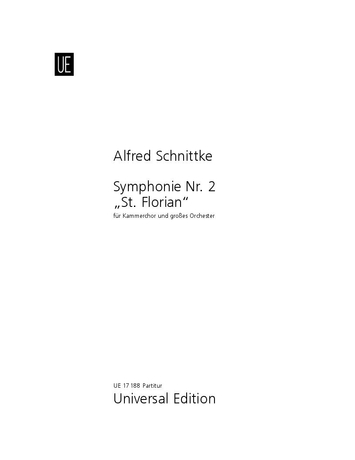.png)
Payments:
Shipping:
Alfred Schnittke
Schnittke: Symphony No. 2 for chamber choir and large orchestra, for chamber choir and large orchestra
UE17188
Release info: Orchestra material on hire
Type: Partitur
Languages: Lateinisch
Format: 250 x 340 mm
ISBN: 9783702432799
Pages: 108
ISMN: 979-0-008-03157-1
Payments:
Shipping:
Description
Alfred Schnittke’s Symphony No 2 is based on the composer’s personal experience in the Austrian collegiate church of St. Florian, which he visited during a trip with friends to the Lockenhaus Chamber Music Festival in 1977. Schnittke describes this experience and his symphony’s origin and conception as follows:
"We reached St. Florian at dusk, when Bruckner’s grave was already closed. The cold, dark baroque church had something mysterious about it. Somewhere in the church a small choir was singing the evening mass: a 'Missa invisibilis'. On entering the church, each of us went in a different direction – to let the cold and powerful size of the building affect each of us alone.
A year later, I received a commission from the BBC Symphony Orchestra for a concert programme which was to be conducted by Gennadij Roshdestvensky. First of all my thoughts turned to a piano concerto; Roshdestvensky however put it to me that I should compose a work dedicated to Bruckner. As I had no ideas on this subject, Roshdestvensky said: 'How about something connected with St. Florian?' That was precisely the right answer. I immediately thought of an 'invisible mass' – a symphony against a choral background.
The movements of the Symphony No 2 follow the traditional order of the mass, and in the choral sections liturgical melodies are quoted. Can a form that ends with the words 'Dona nobis pacem' – give us peace – ever be surpassed?
All the harmony in this symphony is constructed according to the principle of a cross, as too is the form. How, though, can one build up a chord according to the principle of a cross? In this case it results in two chords intermingling; they are not symmetrical, but their intermingling produces a symmetry against which a horizontal motion reacts, so that visually, on the page of the score, a cross appears. I have pursued this thoroughly. It was very important for me to find such a principle of construction, especially for the Credo.
This symphony may at the same time be a mass, but there is less of the mass than of the symphony about it, because the elements which refer to the mass are mostly confined to the beginnings of the movements. A Gregorian hymn is quoted (or two, or one in canon with itself), and then orchestral material is added which is mostly independent and has nothing to do with the chorales – but which is an extension of the chorale. In the process everything vertical is strictly controlled. Everything must accord with the principle of the cross."
Alfred Schnittke
More information
Release info: Orchestra material on hire
Type: Partitur
Languages: Lateinisch
Format: 250 x 340 mm
ISBN: 9783702432799
Pages: 108
ISMN: 979-0-008-03157-1

